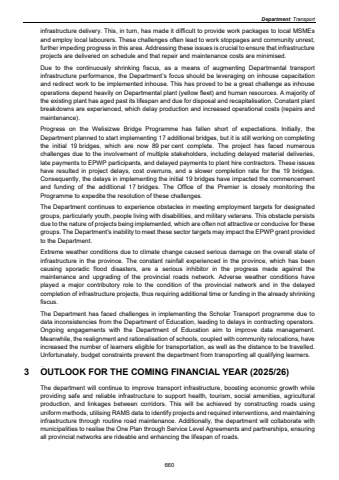Page 681 - Demo
P. 681
Department: Transport infrastructure delivery. This, in turn, has made it difficult to provide work packages to local MSMEs and employ local labourers. These challenges often lead to work stoppages and community unrest, further impeding progress in this area. Addressing these issues is crucial to ensure that infrastructure projects are delivered on schedule and that repair and maintenance costs are minimised. Due to the continuously shrinking fiscus, as a means of augmenting Departmental transport infrastructure performance, the Department%u2019s focus should be leveraging on inhouse capacitation and redirect work to be implemented inhouse. This has proved to be a great challenge as inhouse operations depend heavily on Departmental plant (yellow fleet) and human resources. A majority of the existing plant has aged past its lifespan and due for disposal and recapitalisation. Constant plant breakdowns are experienced, which delay production and increased operational costs (repairs and maintenance). Progress on the Welisizwe Bridge Programme has fallen short of expectations. Initially, the Department planned to start implementing 17 additional bridges, but it is still working on completing the initial 19 bridges, which are now 89 per cent complete. The project has faced numerous challenges due to the involvement of multiple stakeholders, including delayed material deliveries, late payments to EPWP participants, and delayed payments to plant hire contractors. These issues have resulted in project delays, cost overruns, and a slower completion rate for the 19 bridges. Consequently, the delays in implementing the initial 19 bridges have impacted the commencement and funding of the additional 17 bridges. The Office of the Premier is closely monitoring the Programme to expedite the resolution of these challenges. The Department continues to experience obstacles in meeting employment targets for designated groups, particularly youth, people living with disabilities, and military veterans. This obstacle persists due to the nature of projects being implemented, which are often not attractive or conducive for these groups. The Department's inability to meet these sector targets may impact the EPWP grant provided to the Department. Extreme weather conditions due to climate change caused serious damage on the overall state of infrastructure in the province. The constant rainfall experienced in the province, which has been causing sporadic flood disasters, are a serious inhibitor in the progress made against the maintenance and upgrading of the provincial roads network. Adverse weather conditions have played a major contributory role to the condition of the provincial network and in the delayed completion of infrastructure projects, thus requiring additional time or funding in the already shrinking fiscus. The Department has faced challenges in implementing the Scholar Transport programme due to data inconsistencies from the Department of Education, leading to delays in contracting operators. Ongoing engagements with the Department of Education aim to improve data management. Meanwhile, the realignment and rationalisation of schools, coupled with community relocations, have increased the number of learners eligible for transportation, as well as the distance to be travelled. Unfortunately, budget constraints prevent the department from transporting all qualifying learners. 3 OUTLOOK FOR THE COMING FINANCIAL YEAR (2025/26) The department will continue to improve transport infrastructure, boosting economic growth while providing safe and reliable infrastructure to support health, tourism, social amenities, agricultural production, and linkages between corridors. This will be achieved by constructing roads using uniform methods, utilising RAMS data to identify projects and required interventions, and maintaining infrastructure through routine road maintenance. Additionally, the department will collaborate with municipalities to realise the One Plan through Service Level Agreements and partnerships, ensuring all provincial networks are rideable and enhancing the lifespan of roads. 660


